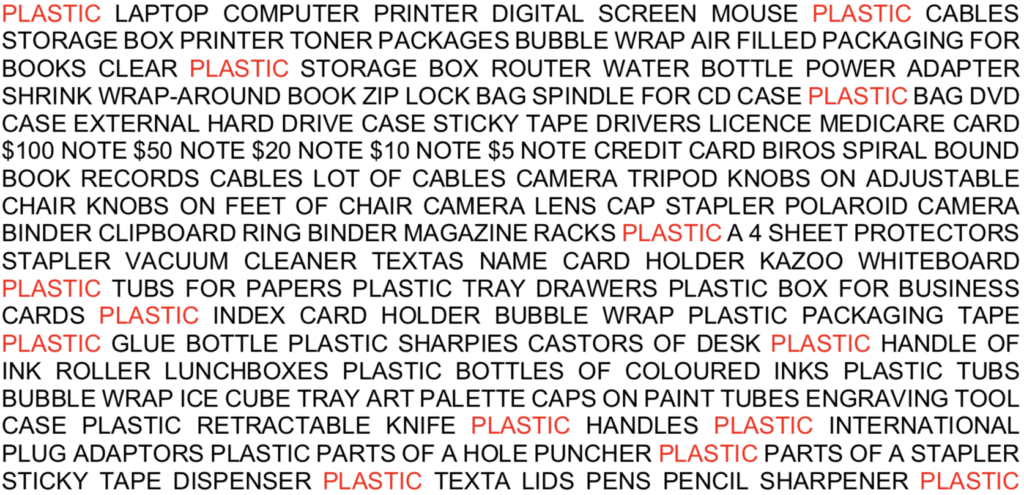
The Biennale of Sydney wants to go plastic-free.
What could this mean? How could this work?
One of the things that the staff (and Artistic Director Brook Andrew) are keen to have is a “manifesto”.
What would a Plastic-free Manifesto look like, and how might it help shunt the organisation closer towards its goal?
It’s a slow process for us, as artists working on the project.
Who takes responsibility for the decisions of the Biennale? How can we speak on behalf of an organisation we don’t belong to? What do we even know about the way the Biennale runs itself?
It’s important for us to do a fair bit of listening before we jump in and start throwing our weight around (although we look forward to doing that too, soon!).
Manifestos are a staple of twentieth century avant-garde western art movements. They declare something to be wrong, and by contrast they announce a righteous path forward! For this, against that! By necessity, they simplify matters.
Here’s George Maciunas in the Fluxus manifesto, declaring what he’s against:
Purge the world of bourgeois sickness, “intellectual”, professional and commercialized culture, purge the world of dead art, imitation, artificial art, abstract art, illusionistic art, mathematical art, — purge the world of “Europanism”!
And here’s Claes Oldenburg, declaring what he’s for (and then dissing what he’s against):
I am for an art that is political-erotical-mystical, that does something other than sit on its ass in a museum.
These for/against manifesti are fun, they give you a bit of a thrill with all their purging and proposing, down with this and up with that. They are revolutionary! Overturn the past, usher in the future. I wish I could make a manifesto as cool as that – crystalline and perfect and simple and imagining a clear path forward. For me personally, though, I tend to get tangled up in the details.
How exactly do we purge the past? Don’t revolutions tend to reproduce the violent regimes they attempt to depose, just with different faces up front? Isn’t it all a bit more complicated that that?
So if we’re against that kind of manifesto, what sort of manifesto are we for? Perhaps we’re with Mierle Laderman Ukeles, who in her “Maintenance Art Manifesto” wrote this:
After the revolution, who is going to pick up the garbage on Monday morning?
Too right Mierle! She acknowledges all the boring stuff – not so much purging anything, rather wiping down surfaces and mopping up the mud off the steps left by all those revolutionaries trooping in and out of the museum to demand its downfall.
Anyway, rather than getting all tangled up in the impossibility of writing a manifesto, we jumped in and had a crack at it. So far we’ve made three versions of a manifesto. They look like poem-thingies. And all three start from the epicentre of our own lives, rather than at the heart of the Biennale itself. That, perhaps, is still to come.
The first Plastic-free Manifesto is a dialogue between Kim and I, our voices loosely separated in columns at the left and right hand side of the page. Perhaps we were subtly influenced by Helen Mayer Harrison and Newton Harrison, with their early dialogical poems reflecting on their process of intervening in ecological situations. At the time of writing this Manifesto (around August 2019), Woolworths supermarket was giving away these little plastic toys called “Ooshies” which my daughter and her friends were wild about collecting – so they make a cameo appearance in the text. Even though Ooshies are a completely forgettable bit of pop-culture, the shitty plastic objects themselves will be with us for a long time to come. UPDATE! If you’d like to hear our voices, in this audio recording we perform the first Plastic-free Manifesto.
Our second Plastic-free Manifesto is a “concrete poem”. It’s an audit of all the plastic objects in my house and Kim’s house. I made my bit of it by using the cool feature on smartphones which records your voice and instantly transcribes it into text. So, just starting at one end of the house and slowly working my way to the other, speaking the names of all the plastic things I can find. The list is vast. Then we laid it out as a giant block of words.
The third Plastic-free Manifesto emerged in collaboration with Aunty Barbara Nicholson, a Wadi-Wadi elder and an old friend of Kim’s in Port Kembla. To coincide with the exhibition launch, the Sydney Biennale is producing a “Reader” – a collective artists’ book, and so they invited us to submit something for it. There was an additional invitation to collaborate with local Traditional Owners to translate (or riff on) our contribution. So we sat down with Aunty Barb for some cups of tea and shared our first attempts at Manifesti with her. She went away and thought about it and came back with a poem of her own, based on her experience of working in a remote community in WA.
Somewhere on the horizon, another Manifesto is lurking. Something that is perhaps more declarative and outcome-directed. My feeling is that the Biennale staff crave something like that – something which risks oversimplification but which they can latch onto as a utopian goal. Maybe a good old-fashioned modernist manifesto is a tool that can be used to prise apart habits and transform organisational policies?
Love all of them, especially ‘Whitefella Trash Not Biodegradable’!
Now THAT is succinct!!!! Just four words, says it all…
(Congratulations Aunty Barbara Nicholson!)
Thanks Eva! Here’s Aunty Barb’s poem, printed at Big Fag Press in a limited edition and framed in – you guessed it – a black faux baroque plastic frame (available at Officeworks for very little outlay)! (As featured in our coronavirus-cancelled exhibition at Cockatoo Island)…